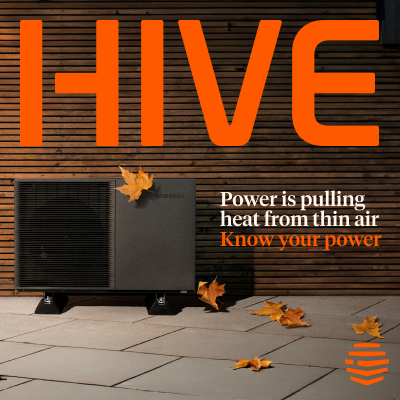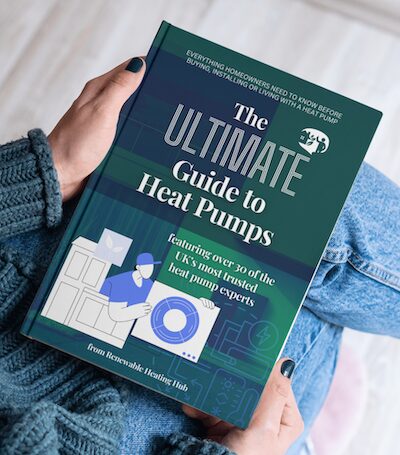How To Balance Radiators & the Role of the Lockshield Valve: A Homeowner's Guide
@jamespa Sounds to me as though the secondary pump may be running too fast and causing mixing in the LLH. You might care to try lowering the speed of that pump in stages and see if matters improve. Regards, Toodles.
Toodles, he heats his home with cold draughts and cooks his food with magnets.
Posted by: @jamespaOK, so 41.9 in from heat pump, 37.1 out to rads, drop of 5C = 10-15% efficiency penalty. Not sure how the return to the heat pump is higher than the return from the rads though, this can be the case if the flow rate from the heat pump is higher than the flow rate to the emitters but in that case the expectation would be that flow temp to emitters is close to flo from HP.
In summary no idea what is going on (one of the reasons to dislike buffers!).
Is it possible that , before I went up to the loft at that time , I noticed the HW tank symbol was on the controller. I did try to determine that by feeling where the valve lever was positioned in relation to each other , as I cant see them I wasnt sure . I can never remember which is closed or open . Perhaps one more visit is required.
Thats another visit done as the DHW icon was off on the controller/ I felt the lever positions again and the dhw was closed as it sprung back to where it sat annd the heating zone was slack Temps now while circulating are HP 40.6 and 32.0 . CH is 35.2 and 30.1 . How does that look .Posted by: @alfapatPosted by: @jamespaOK, so 41.9 in from heat pump, 37.1 out to rads, drop of 5C = 10-15% efficiency penalty. Not sure how the return to the heat pump is higher than the return from the rads though, this can be the case if the flow rate from the heat pump is higher than the flow rate to the emitters but in that case the expectation would be that flow temp to emitters is close to flo from HP.
In summary no idea what is going on (one of the reasons to dislike buffers!).
Is it possible that , before I went up to the loft at that time , I noticed the HW tank symbol was on the controller. I did try to determine that by feeling where the valve lever was positioned in relation to each other , as I cant see them I wasnt sure . I can never remember which is closed or open . Perhaps one more visit is required.
Posted by: @alfapatThats another visit done as the DHW icon was off on the controller/ I felt the lever positions again and the dhw was closed as it sprung back to where it sat annd the heating zone was slack Temps now while circulating are HP 40.6 and 32.0 . CH is 35.2 and 30.1 . How does that look .
Similar really, rads 5C lower than output of ASHP = 10-15% penalty. Difference of 2C on the return possibly a measurement error. I think @toodles might be right secondary may be running too fast. He suggests reducing the speed in that pump see if things improve. You are really looking for feed to rads close in temperature to feed from heat pump.
I wouldn't change it too much though, deltaT across rads already 5, I wouldn't go above say 8. Do you have any control over the speed of the pump on the HP side?
4kW peak of solar PV since 2011; EV and a 1930s house which has been partially renovated to improve its efficiency. 7kW Vaillant heat pump.
I think there is control, there is 1, 11,and 111, written on them, but which pump do I slow if its possible CH pump or HP OUTPUT OR return . Toodles you talk about secondary pump is that HP OUT PUT or CH.
To clarify has the HP classed as primary and inline secondary .
Being dumb again !
@alfapat Not at all dumb, much better to ask before jumping to conclusions. The primary pump will be the one in or attached directly to the output of the heat pump flow pipe. The pump that sits in line with the output from you LLH is the secondary pump and it is this one that you should adjust. Were it running too fast for your set up, it would possibly cause the water flow in the LLH to mix due to turbulence. What you are aiming to do is ensure that the flow through the LLH is as smooth and even as possible so that the stream of water is from the heat pump flow to the emitters and then from the return to the LLH and then to the heat pump return with as little mixing as possible. (Almost as though it was just a straight pipe from flow to emitters and another one from return from emitters to the heat pump.) So, in summary, try slowing the secondary pump down and observe if the difference in temperatures narrows; take it in small stages and pause to see the result. Regards, Toodles.
Toodles, he heats his home with cold draughts and cooks his food with magnets.
Thank you , I will give it a go , so I am looking at the pump returning the flow to the HP .
Just to be clear , I would have thought that turbulance is caused by to much flow into an area like the the tank (which I believe you shorten as LLH) and not getting out as quickly as it can , but by slowing the process down would make it worse.
On the other hand I suppose slowing down the output and not return would take the advantage of building heat from the HP would be lost and everything being held up in the tank and not circulate . Hmm
I will give it a go anyway
@alfapat LLH (Low Loss Header) or you may have a similar device (a buffer tank) basically has the same ports and is in line with the flow from your heat pump. The heat pump primary pump sends the energy in the form of hot water around the circuit so that it flows to the emitters. The secondary pump is there to ensure that the energy is carried around the system once it leaves the LLH or buffer.
The water does not normally need to run a grand prix race but just circulates (relatively) gently to do its’ job. When the water is flowing through the LLH, it may just flow as required or if pushed too hard, will look for other ways to find freedom and escape! This will cause the turbulence (or as it is sometimes referred to as, distortion.
The flow from the heat pump ideally should go straight on to the emitters without being mixed with the return flow at all - but in this less than ideal circuit, some of the water will be diluted with the colder return flow. The balance you are aiming to create allows for the flow to get to the emitters but still have sufficient oomph to keep the return flow to the heat pump after passing through the LLH or buffer on the return journey. More speed or pressure will cause more mixing and lower overall efficiency. Regards, Toodles.
Toodles, he heats his home with cold draughts and cooks his food with magnets.
So I lowered the return flow and will monitor temperature . In the first 1mn I noticed the the flow return up .2c from 31.1 o .31.3!!
Posted by: @alfapatSo I lowered the return flow and will monitor temperature . In the first 1mn I noticed the the flow return up .2c from 31.1 o .31.3!!
12 hours later and after slowing return pump down I get 36.9C and 28.6c HP and for CH 31.5C and 26.5c
@alfapat Sorry, I am a little confused as to which is what here. Might you possibly express the temperatures as flow from HP, flow out of LLH, return to LLH and return from LLH to HP please? We can gain a clearer idea of which is what then I think. Regards, Toodles.
Toodles, he heats his home with cold draughts and cooks his food with magnets.
Posted by: @toodles@alfapat Sorry, I am a little confused as to which is what here. Might you possibly express the temperatures as flow from HP, flow out of LLH, return to LLH and return from LLH to HP please? We can gain a clearer idea of which is what then I think. Regards, Toodles.
Sorry, Flow fromHP 36.9 Flow out of LLH 31.5c Return to LLH 26.5c and Return from LLH to HP 28.6c Doesn’t look good
- 26 Forums
- 2,171 Topics
- 47.8 K Posts
- 41 Online
- 5,744 Members
Join Us!
Podcast Picks
Latest Posts
-
RE: Big Changes Coming to Our Heat Pump System
@jamespa Oh big question but my only thought is to give...
By ASHP-BOBBA , 8 minutes ago
-

-

RE: Mitsu PAR-WT60R Wireless Controller - options
How it does it's job is something of a mystery although...
By Abernyte , 50 minutes ago
-
RE: Testing new controls/monitoring for Midea Clone ASHP
The refresh time of climate-related curves in heating m...
By Tasos , 56 minutes ago
-
RE: MCS certificate SCOP vs real-world performance
MCS:3.65 Reported by Vaillant: 3.96 (heating only); 3....
By JamesPa , 2 hours ago
-
RE: Powerwall 3 or Myenergi or something else?
Yes I was thinking of outdoor, IP65 batteries with buil...
By Temperature_Gradient , 5 hours ago
-
RE: Help me keep the faith with my air source heat pump installation
Water pump will certainly make a hum (which could conce...
By JamesPa , 8 hours ago
-
@jamespa Thanks. Yeah any adjustments Ive made at pr...
By cliffhanger , 8 hours ago
-

RE: How to choose Towel Rails for an ASHP
@rob-nezard yes absolutely. Here is the link and a pho...
By GrahamF , 2 days ago
-

@mixergy Thanks for the update, I would appreciate some...
By bontwoody , 2 days ago
-
RE: Is Your Broadband Router the Weak Link in Your High-Tech Home?
Unfortunately I'm not that well connected 😂 ...
By Scalextrix , 2 days ago
-

RE: A Customer's Lessons Learnt from a Heat Pump Installation in a Large House
It is interesting to see what our new Grant Aerona 290 ...
By GrahamF , 2 days ago
-

RE: Midea ASHP – how to set weather compensation
I noticed that too and thought the same thing, but then...
By cathodeRay , 3 days ago
-

RE: Ya can’t win! It is S*d’s Law!
@old_scientist If IOF is still running next late spring...
By Toodles , 3 days ago
-

RE: Electricity price predictions
Those of you on Agile will do well tomorrow; there are ...
By Toodles , 3 days ago
-
RE: Who’s Caved and Switched the Heating On Already?
We've been running our Ecodan system, installed in June...
By Sheriff Fatman , 3 days ago
-
Ok. Two schools of thought. The first is to run the ...
By JamesPa , 4 days ago
-
@drei Willing as I am to help, I don't think I'm yet ...
By JamesPa , 4 days ago
-
Selling 5 year old ASHP & Gas Combi Boiler - £590
Selling a 5-year-old Daikin Altherma Hybrid Air Source ...
By Paul G , 4 days ago




